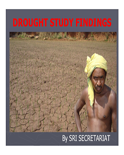A Comparative Study on Drought coping ability of SRI and Conventional method of Paddy Cultivation
During 2009 kharif, out of 526 meteorological districts for which data are available, 215 districts (41%) of the meteorological districts received excess/normal rainfall and the remaining 311 districts (59%) received deficient/scanty rainfall. The agricultural operation of paddy was severely affected due to scanty rainfall in early part of the monsoon. Paddy cultivation area came down to 327.40 lakh hectares compared to normal area of 391.17 lakh hectares. So a study on “A Comparative study on Drought coping ability of SRI (System of Rice Intensification) and CMP (Common Management Practices) method of rice cultivation in India” was carried out through SDTT partners by involving some other institutes within a time frame of two months with the objective on finding out the ability of SRI to cope with drought-like situation in comparison to conventional methods of paddy cultivation as well as presenting suitable management practices for coping with water stress.
For details, please click on the image alongside >>
For details, please click on the image alongside >>
On farm SRI Research Findings (2009-11)
In addition to SRI extension, the program has concentrated upon on-farm research directly through the partner organizations since Kharif’2009 the on-farm research trial on SRI has been conducted in de-centralised agro-climatic zones in 7 different states with objective of refinement of practices of SRI for wider adaptability and documenting the action research findings to be disseminated among various stakeholders including farmers for wider replication of SRI.
For details, please click on the image alongside >>
For details, please click on the image alongside >>


